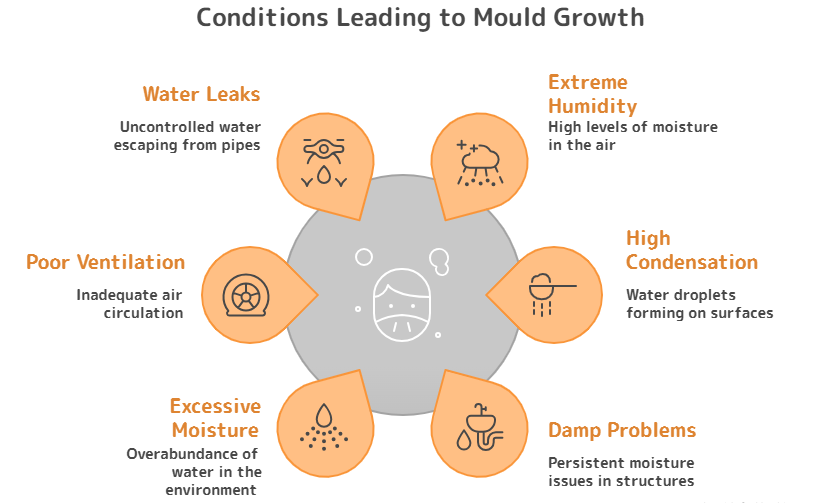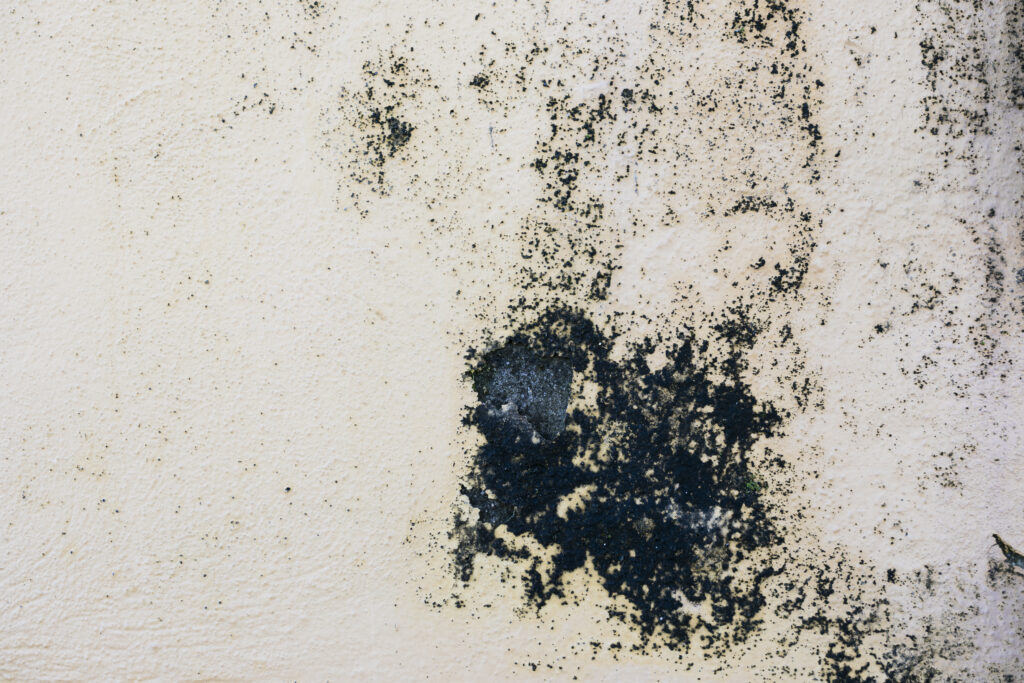Black mould surely affects your immune system by causing minor coughing to long-term respiratory disease. With children and the elderly being at high risk, inspection, air filtration, and proper cleaning can be remedies for their better health.
Black moulds are extremely dangerous if you keep them untreated. While it can cause structural damage to your home, the health consequences are more concerning. For symptoms like sneezing, congestion, and coughing, be wary and check if it’s being caused by the black mould.
The Asthma Australia Report 2022 revealed that people living in mouldy houses are more vulnerable to allergies and asthma. Thankfully, a recent 12% increase in mould removal actions shows that a remedy is possible. Homeowners need to take this issue seriously as their health and property are both at risk from black mould.
Here are some of the most common and serious health hazards caused by black mould and why fast remediation is important.
What Is Black Mould?
Black mould is a small fungus, possibly making your immune system react and causing damage to structures. Scientifically known as Stachybotrys chartarum, black mould tends to grow in more damp, humid and dark environments.
Commonly, these grow behind the wall, in bathrooms, and basements, where necessary moisture for growth is easily available. These fungi can release harmful toxins known as mycotoxins.
What causes mould growth? Here are some perfect conditions and reasons for black mould growth.
- Extreme humidity
- High condensation
- Damp problems
- Excessive moisture
- Poor quality ventilation
- Water leaks
While these grow in moisture-heavy areas of your home, without inspection at regular intervals, they might go unnoticed. It is smart to get your home checked with professionals rather than risking your house and health.

Health Hazards due to Exposure to Black Mould
Black mould is a fungus, producing spores and toxins. Additionally, they release microbial volatile organic compounds or mVOCs that form a bad smell. These spores first cause symptoms which differ from individual to individual.
Most common symptoms are:
- Coughing
- Sneezing
- Mucus drainage in nose
- Congestion in the nose
Some of the long-term effects are respiratory diseases, lowered immunity and asthma problems.
Here are the main health dangers that should concern you.
Respiratory Infections
Black mould releases small spores along with mycotoxins, triggering breathing-related problems. While coughing, sneezing, and nasal congestion are common, not fixing the mould can lead to more serious conditions.
- Mucormycosis: This is quite a rare infection. Mostly caused by mucormycetes fungi, this often leads to a swollen face, headache, vision issues, sinus congestion and fever. This mainly infects through inhalation and affects the weakened immune systems.
- Bronchitis: With consistent exposure to black mould, the common cold and cough can eventually turn into serious conditions like bronchitis. You will suffer from shortness of breath, extreme coughing, mucus release and discomfort in your chest.
For chronic conditions, weight loss, fatigue and conditions like COPD can be the consequences of exposure to black mould for a long time. A professional inspection from mould removal services can eliminate the source of the problem.
Asthma Problem
The spores of black mould are common allergens, often triggering mould allergy or asthma. For people with existing asthma problems, eye inflammation, and sinus problems are common. However, the release of mycotoxins can worsen asthma attacks.
- Allergic Bronchopulmonary Aspergillosis or ABPA: People with weakened immune systems or existing asthma can develop ABPA. This is caused by the severity of the allergic reaction to mould spores. This is particularly caused by Aspergillus fungi, arriving with fever, coughing, mucus or blood and high-risk asthma attacks.
Moulds can tighten your breathing tracts, restricting airflow. Rapid heartbeat and breathing problems are common effects of mould exposure. If you are staying around mould infestation for longer, these breathing troubles get worse and can trigger asthma attacks.
Cognitive Impacts
While mould exposure mainly impacts physical health, it can also take a toll on your mental health. Exposure to black mould, specifically, might affect your cognitive abilities. Mycotoxins are responsible for this as well. The immune response triggered by these mould spores can lead to behavioural problems.
- Impaired Memory: Your memory might suffer because of longer exposure to the unhealthy mould-infested area. Brain fog is something that’s quite common in mould exposure, where you start having blurred recollections.
- Concentration Loss: If you are unable to concentrate on your daily tasks and you have a mould infestation at home, there’s a high chance of these being connected. While short span focus is possible, this mainly affects the long-term concentration.
- Reduced Cognitive Functions: The release of cytokines results in cognitive problems. Release of these chemicals is triggered by black mould exposure.
However, note that this does not lead to complete memory wiping, focus loss and cognitive disruption. Take actions to eliminate mould so that it does not affect your daily life and brain functioning. Get help from competent professionals to remove the mould to avoid such severe health impacts.
Weakened Immune System
Your overall health is affected by black mould exposure as it weakens your immune system.
- Allergy symptoms are seen when the immune system is impacted by the spores.
- Your immune system releases specific chemicals as a reaction, inflaming the nose.
- Even without existing allergies, your immune system weakens, causing mVOC irritation.
Health Effects of Black Mould Exposure
| Category | Short-Term Health Effects | Long-Term / Chronic Health Effects |
|---|---|---|
| Respiratory System | Coughing, wheezing, throat irritation, nasal congestion, sinus infections | Chronic bronchitis, asthma flare-ups, lung infections, long-term reduced lung function |
| Allergic Reactions | Sneezing, runny/stuffy nose, red/itchy eyes, skin rashes | Severe allergic responses, persistent rhinitis, eczema worsening |
| Neurological & Cognitive | Headaches, dizziness, fatigue, difficulty concentrating | Memory issues, mood swings, confusion, possible neurological disorders with prolonged exposure |
| Immune System | Mild immune suppression, frequent colds | Weakened immunity, higher susceptibility to infections |
| Children & Elderly | Irritability, breathing difficulties, more frequent illnesses | Developmental respiratory issues in children, worsened chronic conditions in elderly |
| Severe Cases (Toxic Exposure) | Nausea, irritation in eyes and skin | Organ damage (rare, but possible in prolonged heavy exposure), severe asthma attacks |
Table 1: Health Effects of Black Mould Exposure
While a number of health risks are presented, their severity really depends on how long you are exposed to the mould and how bad the infestation is.
Need For Quick Remediation
Black moulds usually grow in moisture-heavy, damp environments. Longer exposure can affect you both physically and psychologically. Hence, an immediate solution can help you stay away from severe lung-related health conditions.
Rapid Spread
The character of mould spores is to spread rapidly with the right moisture and favourable temperatures. Mould spreads within 24 to 48 hours, making it more threatening for your health. The rapid growth not only causes structural damage to your home but severely affects your lungs, further leading to serious conditions like bronchitis and asthma.
Treatment Cost with Delayed Mould Treatment
When you are affected by these severe conditions, the average cost of treatment can be high. You can avoid the treatment cost with quick action for mould removal. It is smarter to put the cost in preventive measures than in medication.
A fast action with a professional mould removal service saves your building from facilitating chronic lung conditions.
Steps for Professional Mould Remediation
In case you’re dealing with black mould, it’s important to follow a tested procedure with the experts. Here is how it is usually done in Australia.
- Connect With a Mould Assessment Service: Start by connecting with an expert mould assessor specialising in inspections and testing. You can share your concerns with them and let them explain to you the process.
- Book a Professional Inspection: The assigned professional from the mould assessment service will visit your place to carry out detailed inspections with tools like air quality testing and moisture mapping. This can help in finding the infestation source and deciding if the place is safe for you to live.
- Get a Detailed Report: The findings of the mould assessment service will be the basis of their detailed report. This outlines the severity of mould infestation, the risks associated and possible remedies.
- Relocate if Needed: If the assessor advises relocating to an alternative house until your current accommodation is safe again.
- Find a Mould Remediation Service: With the report from the mould assessor, find a licensed remediation expert. They can carry out the mould removal with tools designed to eliminate contamination.
It is best to call in a service that specialises in mould assessment, as you might struggle on your own to find the source, reasons and remedies of the problem. Follow up by connecting with mould remediators for the actual removal.
In Summation
Black mould can mess with the structural integrity of your building, but more importantly, affect your health. Avoid severe respiratory conditions caused by black mould by getting mould experts to inspect the place and assess the severity of the black mould infestation.
Are You Looking for Quality Mould Testing and Assessment Services in Australia?
Visit our website to check the services and equipment used by us for mould testing and connect to get your office or home inspected!
Frequently Asked Questions
Is Black Mould Assessment and Remediation Covered by Home Insurance in Australia?
For most cases, mould damage is not covered by insurance unless its source is an insured event like the bursting of a pipe. Check your policy details or connect with the insurer.
Will Mould Come Back After Removal by a Professional?
If the main problem of moisture is not properly fixed, it can recur. Remediation, however, addresses the removal and addressing of sources like water leaks. Check it after the removal is done.
How Often Should I Get My Home Inspected for Mould?
Yearly inspections are a smart idea, especially if your accommodation is in a humid location. Detection in the early stage can prevent expensive damage repairs.
How Long Does Mould Assessment Take?
Most assessments take from 1 to 3 hours, but can take longer depending on the size of the house. Check the number of areas affected to know the exact time needed for inspection.


